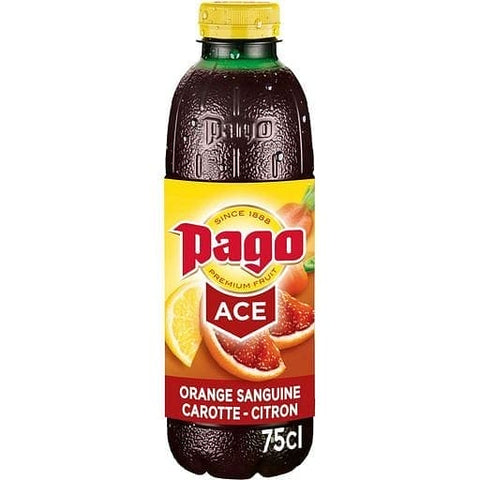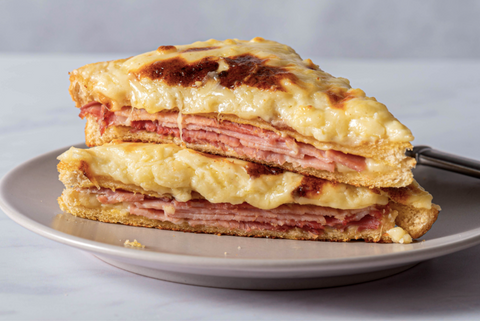A baguette is a long, thin loaf of French bread that is commonly made from the basic lean dough (the dough, though not the shape, is defined by French law). It is distinguishable by its length and crisp crust. A baguette has a diameter of about 5 or 6 centimeters (2.0 or 2.4 in) and a usual length of about 65 centimeters (26 in), although a baguette can be up to 1 meter (39 in) long.
The word baguette was not used to refer to a type of bread until 1920, and it did not enter popular use until North Africa during World War II. The "classic" baguette is white, made with refined wheat flour, and contains no more than 10 percent oatmeal or cracked whole wheat grains. It is illegal for bread such as baguettes to have any additives other than yeast, salt, and water in France. Baguettes are closely connected to France and are one of the country's best-known symbols worldwide.
Difference between a Baguette and a French Baguette
"Baguette" and "French baguette" are often used interchangeably. However, it's important to know the difference between these two delectable treats before you take a bite of one or the other.
Baguette
The word "baguette" is French, meaning "stick," which refers to the shape of traditional French baguettes - they usually look like a long stick. Baguettes are crusty on the outside and moist inside, with a light texture and flavor.
French baguette
A French baguette is just that - from France. It has a crisp crust, small holes, and an airy texture. The taste can be bland, but it's often served with butter or olive oil for additional flavor.
French Baguettes are so good
According to several experts, there are three main reasons why French baguettes are so delicious.
- First and foremost, the flour used in France is of very high quality. But the major difference between French and an American baguette is the fermentation process.
- Most French bakers use a poolish process, which consists of a mix of yeast and water that's allowed to ferment overnight. The next day, this mixture is added to the rest of the ingredients. This gives the dough more flavor and aroma.
In addition, French bakers use steam for baking their baguettes, which allows them to get a crispy crust without drying out the bread. This makes for a soft and moist inside with a golden-brown crust.
Types of Baguettes in France
According to
kingarthurbaking there are many different baguettes in France, and each region and even a town or village might have its take on the national bread.
- The most famous type of baguette is the traditional white one, and there are dozens of variations on that theme. For instance, you might get a "baguette poids de King" (the weight of a king), which is very long, a "baguette au levain" (sourdough), or a "baguette sesame" (with sesame seeds).
- There are also baguettes with nuts, chocolate chips, olives, corn, sometimes called the "pain de ménage" (house bread), and many other versions. And there are regional specialties such as the flute in the east or the fougasse in Provence.
- In addition to these standard types of bread, there are now all kinds of fancy gourmet baguettes, too, as bakers try to tempt customers from the chains like Paul or Brioche Dorée. So you might find a rosemary and olive oil baguette, for example!
French bread is different from Regular Bread
- Besides the obvious fact that French bread is typically longer and thinner than regular loaves, it tends to be less sweet and has a crispier crust.
- French bread is usually also made with very simple ingredients instead of sandwich bread, which can have many different additives. So instead, it's usually just flour, water, yeast, and salt.
- French bread is also made very differently than sandwich bread. The dough is shaped into long narrow loaves before baking, whereas sandwich bread doughs are kneaded and raised at least twice before shaping.
What makes French bread so hard?
The answer, it turns out, has less to do with science than you might expect. Hard bread has been an issue in France for centuries, dating back to when flour was scarce and bakers had to make do with whatever they could find. A common trick was to stretch the dough as thin as possible and let it dry out on a hot oven floor. The result was a crunchy crust and a rock-hard interior that could be used for anything from dipping in soup to crushing insects — and everything in between!
What is a half baguette in France?
A demi-baguette is a half baguette, "demi" means half. A demi-baguette is cut in half lengthwise and sold as such.
Quarter baguettes are also available, but they are rarely called that. Instead, they are called "one tranche de baguette" (a slice of baguette).
We've got a whole bunch of regional nicknames for the demi-baguette in France - here's a list of some that I know about:
-
Demi baguette: the southern versions are particularly common because the half baguette is more common there.
-
Ficelle (a string): a long, thin baguette is called ficelle in French, so this is another clever little reference to that.
-
Stamp baguette: stamp comes from Empreinte (meaning imprint), so this refers to how it's stamped with the bakery's name when it's sold.
-
Baguette (little baguette): simply because it's smaller than a normal baguette.
-
Petite baguette: same as the little baguettes.
What is a large Baguette?
It's called a ficelle, which is French for string.
A baguette is a long thin loaf of French bread commonly made from the basic lean dough (the dough, though not the shape, is defined by French law). It is distinguishable by its length and crisp crust.
Is Baguette the same as Sourdough?
The baguette is not a type of bread; it is the shape. Like a loaf is a shape, or around is a form. Bread can be made in many different shapes, and there are particular names for them.
For example, a round loaf may be called a bâtard (a French term for bastard), or an oval loaf might be called a niche (another French term). As you describe it, a long thin loaf is called a ficelle (French for string).
- A baguette is simply the same thing but with less curvature in the sides and is quite straight. The word baguette means wand or stick - the shape it resembles.
- Sourdough bread is made using naturally occurring yeasts to make the dough rise, rather than adding dried yeast to the dough. As a result, a piece of sourdough bread will often take far longer to rise than one made with dried yeast but can also have much more flavor.
So yes, you could have a sourdough ficelle, or indeed any other shaped bread.
French baguette is to be considered white Bread
- A baguette is a French bread shaped like a long, thin loaf with a crisp and crunchy crust.
- A baguette is made of wheat flour, yeast, salt, and water. It is characterized by the crisp and crunchy crust but is soft inside.
- Baguette is widely known for its taste and texture; it is usually baked in a stone oven. The bread requires a certain way of handling when it comes to cooking. It could take up to 20 minutes to cook; nevertheless, it yields the best results.
- The white bread has a soft textured interior with a soft crust. Unlike baguette bread, white bread can be made from any flour that is refined or unrefined. Therefore, its flour may be white or whole-grain but still considered white bread.
French Baguettes go stale so quickly
The crisp crust and soft, fluffy center of a French baguette is one of life's great pleasures. But the bread is so soft that it gets stale quickly—the reason why has to do with water.
While most bread has a fairly high water content (usually around 40 percent), the water content of baguettes is much higher — usually about 50 percent. That gives baguettes their light and airy texture, which also means they dry out quickly.
There are two main types of starch in bread:
Amylose and Amylopectin: Amylose is one long chain of sugar molecules, whereas amylopectin has many branches and forks. Most starches contain some mixture of the two, but there are exceptions. For example, wheat starch has only 3 to 5 percent amylose, whereas rice has about 20 percent.
The ratio between amylose and amylopectin determines how your bread will react to liquid. For example, imagine you have a cup full of uncooked spaghetti noodles floating in the water. Adding a drop of food coloring to the cup will spread throughout the entire cup as the color diffuses through the water. This is what happens when you add water to bread that contains mostly.
What do you eat with French baguettes?
Baguettes are bread, and bread should be eaten with anything.
- That being said, the most common thing to eat with a baguette is cheese. Cheese on a slice of baguette is one of the most common meals in France. Just put whatever you like (camembert, rouy, mozzarella...), and you're good to go.
- You can also make sandwiches by adding ham, egg, or tomatoes. Any kind of sandwich will be good.
- Bread and butter are also very common in France, especially for breakfast. It's usually eaten with pastry, jam, or chocolate spread.
Taste of Baguette
If you want to know what baguette tastes like, that's a bit difficult to answer. Baguette is the most common type of bread in France, and it's kind of difficult to describe it compared to other kinds of bread because it's so common!
It is a long, thin loaf of bread with a crisp crust and soft interior. It's not sweet, but not salty either. Baguettes can be bought for about 1 euro in any French bakery or supermarket. You can find even cheaper ones in supermarkets, but don't buy them! The quality is bad, and they are full of preservatives. They also have a different crust: they don't have the characteristic hard crust that baked-for-you baguettes have.
The best way to eat a baguette is with some butter (or margarine) and jam, or by itself if you're on a diet as
in en Wikipedia.
What Cheese goes well with a Baguette?
Brie, Camembert, and Havarti are great cheeses to pair with baguettes.
- Brie has a creamy texture and a mild flavor.
- Camembert is another soft cheese that melts wonderfully when baked.
- Havarti has a creamy texture and buttery flavor that pairs well with the crunch of fresh bread.
Baguettes are great bread, as they are long and thin, which allows you to eat them in one or two bites. However, they are not always the best choice for a cheese sandwich because they tend to be too crunchy and hard to bite into.
If you're looking for an alternative to baguettes that are more suitable for sandwiches, try focaccia bread or sourdough bread. Focaccia bread is Italian bread made with olive oil and herbs. It's softer than baguettes and has a nice flavor that goes well with cheese. Sourdough bread is another good choice because it's also very soft and has a slightly salty taste that complements cheese well.
Baguettes in UK
The UK has an enduring love affair with the baguette, despite a common misconception that the French are more passionate about the French stick than the British.
According to new research released today by The Grocer – in partnership with Allinson's – the UK's appetite for baguettes shows no sign of slowing down.
- 25% of consumers eat a baguette at least once a week, and half have one at least once a month. And they're not just eating them at lunchtime: nearly 10% of consumers eat a baguette every day - with almost half (48%) opting for a sandwich with ham, cheese & salad.
- The baguette is the most popular bread in France today. It takes only a few minutes to make, and it takes 10 minutes to bake. It's simple bread made with white flour, yeast, salt, and water. The crust is crispy, and the inside is light and airy. It's perfect for sandwiches or to eat on its own.
The popularity of baguettes in the UK has grown considerably over the last decade, and it's easy to see why. Not only are they delicious, but they're also incredibly versatile. They can be filled with almost anything, from meats and cheeses to vegetables and fruits.
According to
masterclass they're also very convenient because you can grab one from your local bakery at any time of day or night. But if you have time to make them yourself at home, here's a recipe that will help you create your version of this classic French bread.






